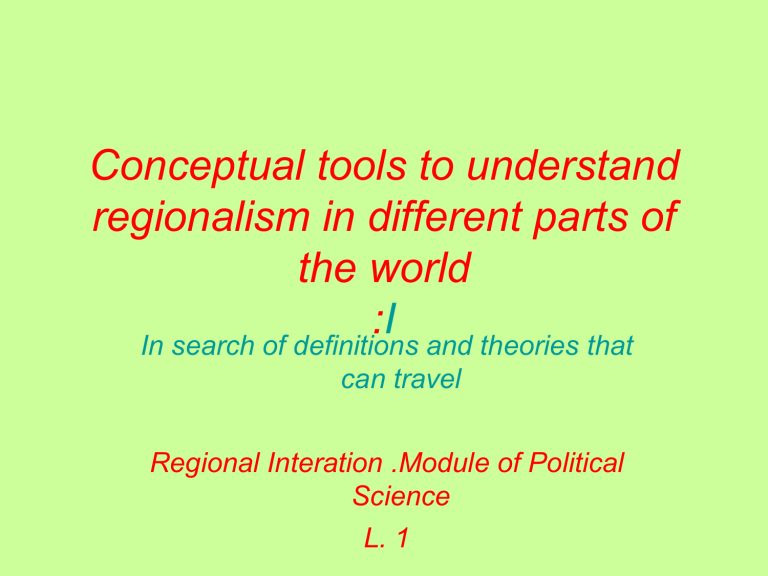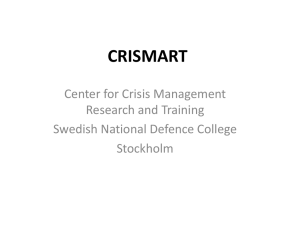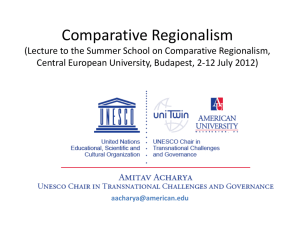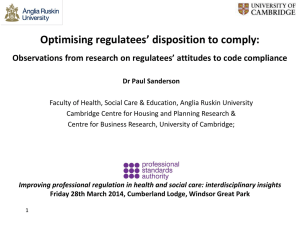Dimensions of Regionalism (Hurrel 1999)

Conceptual tools to understand regionalism in different parts of the world
: I
In search of definitions and theories that can travel
Regional Interation .Module of Political
Science
L. 1
Why definitions ?
“ One of the biggest obstacles facing students of comparative regionalism is the c onceptual one . There is a wide range of definitions of region, regional integration,regionalism, regionalisation and related concepts in the academic literature..... Definitions are ... essential in comparative research, since the definition and choice of concepts, including the fundamental question of what is a case, will affect the ability to compare and ultimately to generalise.”
1st step identifying the dependent variable:REGION
P.De Lombaerde, F.Soederbaum, L. Van Langenhove, F. Baert, The problem of comparison in comparative regionalism , Review of International Studies, 36 (2010) p.735)
What is a region?
Scholars of economic background tend to define regions in terms of increased economic interdependence , as integrated market places
In this course we look at regions as political and administrative units.
Regions don’t emanate simply from the forces of geographic proximity and the intensity of economic flows , but are the product of policy choices by national decision makers
What is a region ?
Regions may be defined by what they are not: they are not sovereign states.
But tehy have some resemblance to states the concept of regionhood help to distinguish between a region from a non-region.
Regionhood (region-ness) sees regions as nonsovereign governance systems with (partial) statheood properties .
The emphasis is on process rather than a specific institutional model or a priori definition of region .
(Soderbaum et al.)
What is a region ?
Agreement of the fact that regions imply:
Geographical proximity
Mutual interdependence
Some scholars maintain they imply also:
Some cultural homogeineity
Or a shared identity (sense of “we-being”)
Regionalization
Regionalization refers to the growth of societal integration within a region and to the often undirected processes of social and economic interaction.
( regional complex)
Essentially greater economic interdependence within a geographical area than between that area and rest of the world.
Main drivers are the market and economic actors.
Trade but also people and ideas.
Main point is that is not based on purposeful action of states neither presuppose impact on the relations between the states
REGIONALISM (def 1)
• Refers to processes and structures of region building in terms of closer economic, political, security and social cultural linkages between states and societies that are geographically proximate
• (Boerzel 2011)
REGIONALISM
vs
REGIONALIZATION
Regionalsim as a state-led project based on intergovernmental negotiations and treaties . It generally includes structures and processes of region-building in view of closer relations on economic, security and socio-cultural level.
Clearly distinguished from regionalization
,which refer to an increasing of intraregional soscio-economic interactions among private actors.
OUTCOMES of REGIONALISM
The outcomes of regionalism can take various forms ranging from regional cooperation to regional integration.
Integration and cooperation
• Conflict ----------------- Cooperation
• Integration is a subset of cooperation , not the most frequent. Regional integration and regional cooperation are the opposite ends of a continuum
• Integration is not just increasing trade flows or more intense transborder communication
Integration
is not
Convergence
• A further distinction :
• Integration means that m.s. get ever closer
• Convergence means that states become more similar .
• Greece is closer to Germany (single currency, membership of NATO) than
Sweden to Norway, but the latter are more similar.
Dimensions of regional integration
• Balassa’s typology collapses two dimensions of regional integration which should be kept separate:
• -
scope or breath of policy integration
• depth of integration
scope or breath of policy integration
• Refers to the issues to be dealt with at regional level
• These issues do not only include the dismantling of national barriers to market exchange ( market-making) and dealing with negative externalities of liberalization
(market-correcting).
• They may include security, constitutional issues, social issues .
• The more the issues included in the regional agenda , the broader integration becomes
• Also referred to as “FUNCTIONAL DEEPENING”
depth of integration
• Concerns the political authority that regional institutions have on issues delegated to them .
• Weakest form of delegation regards administrative tasks (organizing intergovernmental meetings , passing information)
• Strong form regards the power to adopt collectively binding decisions (legislative authority) , implementing them(executive authority) and autonomy in dispute setting (adjudicative authority)
• Also referred to as INSTITUTIONAL DEEPENING
REGIONAL INSTITUTIONS
Depending on how much autonomy regional institutions have in excercising their authority and how much they can encroach on national soveregnity rights , they can be defined :
INTERGOVERNMENTALIST (low authonomy)
SUPRANATIONALIST (high autonomy)
Orientation
• Irrespective of their degree of formal supranationality regional organizations may tend to privilege either the authority of formal impersonal institutions or the decisions of specific personal power-holders .
• The orientation depends more on the state-society relations prevailing in the major states than on the nature of institutional arrangements.
• Regional oragnization can be :
• More Rule-oriented (EU )
Or more
• Power Oriented (“presidential diplomacy” in
MERCOSUR)
Regional organization s
The regional organization we consider here must be characterized by
• More than 2 member states
• Geographical proximity
• Exclusive membership
• Serve multiple purposes
Dimensions of the evolution of regional organizations
WIDENING (enlargement) including newm.s
.
DEEPENING
FUNCTIONAL (breadth
->issue areas)
AUTHORITY of regional institutions
Regionalism-Regional integration (def.)
• Haas(1961) “process of how and why nation states volountary mingle, merge and mix with their neibourghs so as to loose the factual attributes of sovereignity while acquiring new techniques for resolving conflicts among themselves”
• + (Schmitter 2004) “by creating common and permanent institutions capable of making decisions binding on all members”
Mapping forms of regional cooperation and integration
Schmitter 2007
Regional cooperation and regional integration : how to distinguish between them?
• Scmitter (2007) three characteristics suffice not only to describe trans-regional organizations but to predict their behaviour and future evolution:
• Variable 1 : The Rules that govern their decisionmaking
• Variable 2 : The Costs and Benefits that ensue from membership (and the costs of exit from membership)
• Variable 3 : The Actors involved in their activities
From these three variables one can distinguish between regional cooperation and regional integration and lay the foundation for analyzing their distinctive dynamics, as well as their eventual interconnections.
Forms of regional cooperation and integration
Cost and benefits of membership
LOW
Decision-making rule
MEDIUM HIGH
Unanimity Symbolic
1
Consensus Functional
4
Status
Conferring
2
CONFEDERAL
5
Imperial
3
Consortial
6
Majority impossible
Condominial
7
Federal
8
Forms of regional cooperation and integration
• The two extreme cases are :
• 1 Symbolic -unanimity rule (no delegation of authority to regional institutions) and low costs of exit(or benefits of membership)
• 8. Federal –from individual nations states to a new
State (US; EU not yet)
• .
Forms of regional cooperation and integration
Where to locate the EU?
EU - consensus rule or possibility to opt-out:
6 Consortial consensus rule and high benefits and costs of exit or 7 Condominial when the decision rule may be majority but there are possibilities of opting-out.
depending on issue area and decision rules provided for it by the Treaties
Forms of regional integration and cooperation
4 Functional and 2 Status conferring forms of regional cooperation differring in terms of decision rules and costs of exit
Forms of regional integration and cooperation
I mperial regional cooperation dominated by an hegemon who imposes unanimity and high costs of exit for members
Forms of regional integration and cooperation
Confederalis a consensus oriented form of cooperation that starts to provide benefits .
M.s. are sort of “locked in” cooperation because exits costs are relatively high but don’t give up sovereignity
Marks the transition from cooperation to possible integration : m.s. may decide for deepening (ex:by adopting majority rule)
Third dimensions:number of actors
• Regional cooperation and regional integration tend to involve different sets of actors.
• Regional cooperation ministers, normally foreign ministers
• Regional integration civil servants of the m.s., interest groups , non-governmental oragnizations,social movements.
A new wave of regionalism?
• In 2010
467 regional accords
Registered by the WTO
271 in force
ONLY 9 Custom Unions
40% no more than 2 partners not contigous
(50% 2 partners from distant regions)
90% PTA or FTA
ONLY 5 common markets
Most of important regional organizations (multiple isuues) originated well before
1990 some were re-established ater the end of the Cold War
Two trends
Classical regional economic cooperation
-->shallow economic regionalism
Forms of regional cooperation that seem to have evolved towards regional integration (deepening and braodening the scope of cooperation) that present some institutional similarities
•
A new wave of regionalism?
• Old and new regionalism a false divide
.
• But in major regional organizations a trend towards delegation of new policy competences and more political authority:
– From FTA to CU to Common markets
– New areas of cooperation :external and internal security
(fighting terrorism, managing migrations)
– Still reluctance on the part of member states to delegate political authority but institutionalization of decision procedures (with some openings to MV) and mechamisms of dispute settlement, setting up of parliamentary assemblies with a consultative role.
Maps from Boerzel 2012
LEGITIMACY
• Since legitimacy is generally a property of nation states, when authority is delegated to supranational institutions the issue of the legitimacy of these institutions and their decisions becomes prominent.
• When the institutional arrangement is intergovermentalism (and the decision rule consensus or unanimity) the legitimacy of the decision resides in the legitimacy of the goverments' of member states that have agreed on that decision.
• But what about decisions of supranational authorities or taken with supranational rules
(majority) ?
Types of legitimacy
Fritz W. Scharpf (1999) proposed to differentiate between two types of beliefs about the democratic legitimacy of a political order – inputand output-oriented legitimacy .
Reference is to work of David Easton (1965), who defined input into the political system as consisting of citizens’ demands and support
(conferred not only through elections but also by citizen identity and sense of system legitimacy) and output as consisting of government decisions and actions
„Scharpf assigns to the two types legitimacy one aspect of Lincolns phrase of a government of the people, by the people, for the people .
Types of legitimacy
• Scharpf and Schmidt with reference to the EU define 3 types of legitimacy
– INPUT legitimacy
– OUTPUT legitimacy
– legitimacy OF
THROUGHPUT
(V. Schmidt 2009)
INPUT legitimacy
• GOVERNMENT BY THE PEOPLE
• the democratic quality of the political process
• Authorization “from below”
• “democratic deficit in the EU”
OUTPUT legitimacy
• GOVERNMENT FOR THE PEOPLE
• Here, political choices are legitimate if and because they effectively promote the common welfare of the constituency in question.‟
• There are three kinds of performance to which output-oriented theories typically put down the democratic legitimacy of a political system: prevention of tyranny, realisation of the common good and economic prosperity (Scharpf 1970:
21-25).
legitimacy OF THROUGHPUT
• GOVERNMENT WITH THE PEOPLE
• “throughput” efficiency, accountability, transparency, and openness to consultation with the people of the ( EU’s ) internal governance processes.
• “Community method”
• “new modes of governance” open coordination method











